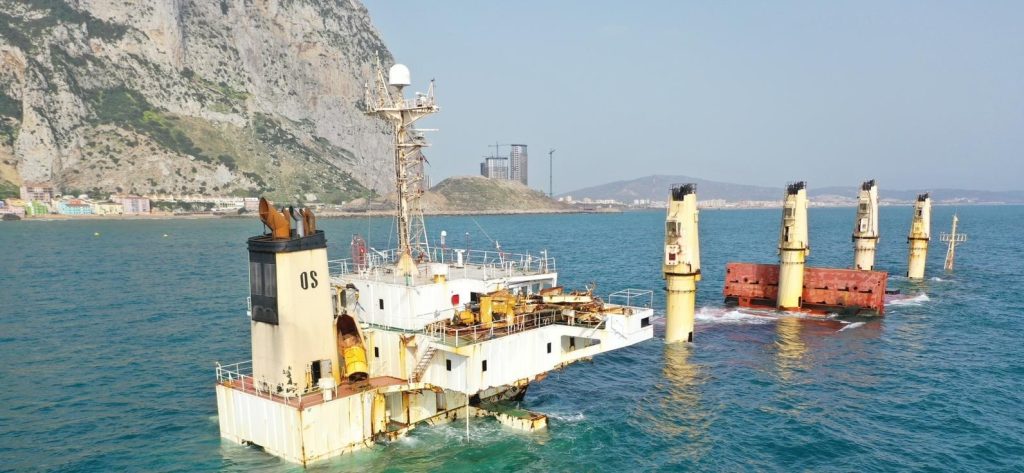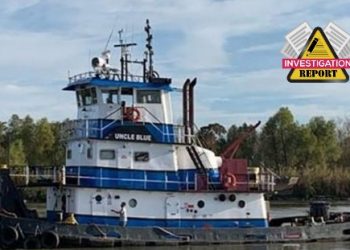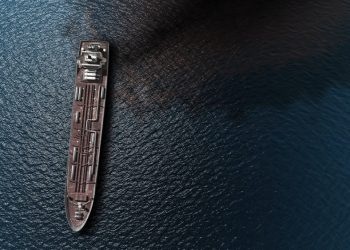Port of Gibraltar has released a survey report detailing the damage sustained by the OS 35 wreck as a result of recent storms. The wreck, which must be removed by May 30th, suffered further damage on its hull and fuel tank 1.
The chronicles of the OS 35 wreck begun on August 30, 2022 when the bulker was breached after it collided with an LNG carrier. OS 35 was ordered to come close to shore to minimize the risk of it sinking.
As the vessel was beginning to break apart, the Port had two tugboats and other vessels standing by and the decision was made to evacuate OS 35, removing 24 crew members. This resulted in the vessel resting on the seabed in 17 m of water, listing by three degrees to starboard. The major concern then was the 183 tons of heavy fuel oil, 250 tons of diesel, and 27 tons of lube oil aboard the vessel.
The Gibraltar Port Authority put a containment boom around the vessel and another at the crane, while the salvage team assessed that it would take at least 50 hours to pump all the fluids off the vessel. The ship was leaking hydraulic fluid from the forward crane and the Port abandoned all thoughts of refloating the bulker. Instead, they focused on removing the oil from the ship.
In October of 2022, The Port Authority of Gibraltar issued the owners of the OS35 with a wreck removal notice by 30th May, 2023.
At the start of 2023, salvage operations started off Gibraltar to remove the wreck of the bulker OS 35 by May 30, 2023. The anchor handling tug Koole 42 along with Barge H-283 were deployed early in January from Suriname. The team was working to remove two additional booms so that they would be able to gain access to the cargo holds. Port officials opened the cargo hatches and the first phase of the salvage operation is fully underway. This effort focused on removing and then recycling the cargo which consisted of a load of 33,632 tons of steel bars.
However, On February 21st of 2023, after bad weather tar balls were detected in Catalan Bay and the boom was redeployed around the OS 35. P&I club contractors, monitored by GPA and Department of Environment staff, worked on cleaning Eastern Beach. P&I club was provided information by the Port, so that they would be aware of the affected beaches in La Linea in order to offer any assistance they can to the Spanish authorities in respect of their clean-up efforts.
On March 7th, the Port of Gibraltar released a Survey Report with details from the storm damage:
- While the wreck has sustained structural damage, most notably to the starboard side of the accommodation block and hull, this is not considered extensive given the overall situation. The wreckage has contained the debris.
- The original crack in the hull has spread to the Port side, and the two halves of the ship are presently tenuously held together by the very bottom part of its structure, known as the bilge keel.
- Divers have confirmed that all four tanks that comprise ‘Tank 1’ have been damaged. There was still some light sheening, which was successfully contained within the boom.
- The other set of fuel tanks, No 2 Fuel Tanks, are undamaged and are located in the wreck’s aft area, which has not been damaged. The dive survey confirmed unequivocally that these tanks are not in danger of failing and causing a sudden release of residues.

Port of Gibraltar has also reinstated that the priority lies with removing the ship’s cargo, as over 11,000 tonnes (roughly one-third of the total cargo) already removed. The downtime caused by the winter storms was factored into the project timeline.
Because of the wreck’s current condition and damage to its hull and structure, some of the plans for its final removal may need to be revised, though it is unclear how this will affect the projected timelines, if at all.































































Because the removal of the wreck is so complicated, I wonder what port authorities around the world, have organized, to remove them as a whole. Was the captain drunk, when his ship collided? Who pays for the catastrophe?
Are ships movements monitored? And if not, why not